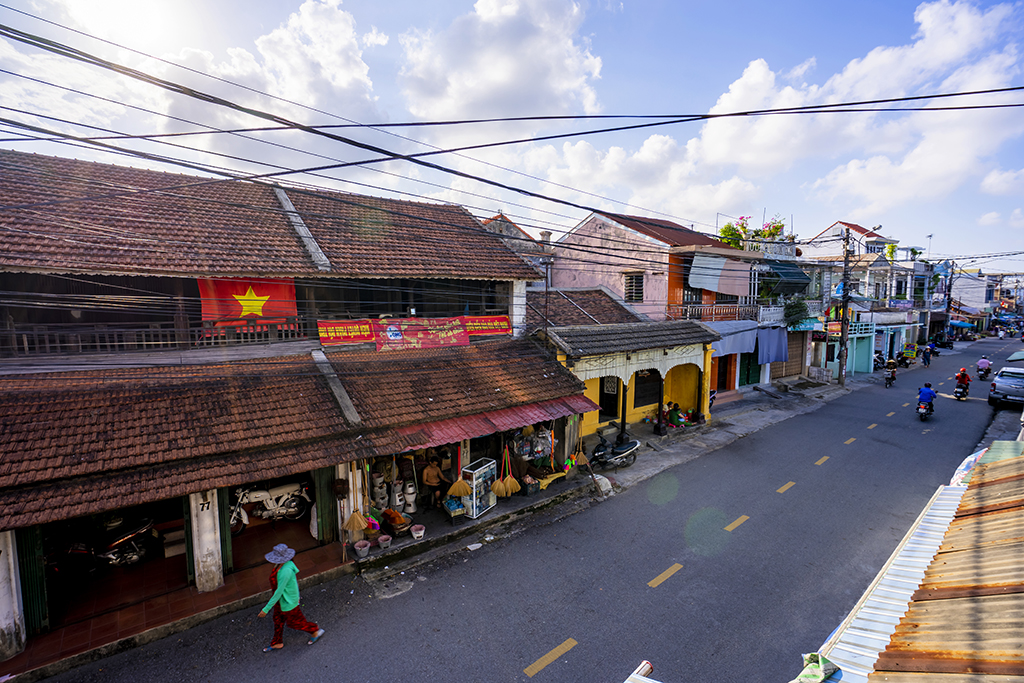
Bao Vinh ancient town
“This communal house has been degrading for a long time. It’s going to be restored. The fund has been approved. We’re very happy,” said Mr. Doan Van San, Head of Bao Vinh Village.
I looked at the communal house. Its tiled roof was badly damaged, but the altar inside was well tended. Sipping tea with San and some other elderly men in the village, I was told more about the once-famous Bao Vinh area. In their stories, I felt their love, pride, and regret because it is no longer a bustling business place as it was in the past.
Hue City has just been expanded to include Bao Vinh as Huong Vinh Ward now (formerly belonging to Huong Vinh Commune, Huong Tra Town). According to San, it is good news. People hope Bao Vinh will be invested to develop its tourism and its temples and pagodas will be repaired.
I quite sympathize with a man from Bao Vinh like him. He saves all his love for his hometown, wanting to see his Bao Vinh develop and become as busy as before.
I walked on a small street, passing the Bao Vinh market, groceries, drugstores, and ancient houses some of which had up to five departments, trying to visualize the bustling quarter in the 17th century. When Bao Vinh replaced the commercial port of Thanh Ha, foreign merchant ships arrived at the Bao Vinh wharf. At that time, Bao Vinh had many big merchants dealing in commodities such as iron, steel, rice, and salt.
At the time, salt was as precious as rice. Only big merchants traded in salt. What I like now is that at Bao Vinh, many shops still sell earthen pots and bamboo baskets, which makes the ancient quarter look rustic.
Showing me the black and white photo of the big sailing ships anchored in Bao Vinh, Mr. Le Quang Chat told me that at that time, in addition to iron and steel, many “luxury goods” were available at Bao Vinh Market such as pottery from Japan, felt from England, brocade from Shanghai, jade and wine from France, etc.
According to Mr. Le Quang Chat, the ladies in the Imperial City and the princesses of the Nguyen Dynasty liked British felt very much because the winter in Hue was very cold. On the trip back, foreign merchant ships brought rice, silk, agarwood, and precious woods. In particular, silk woven by women in Kim Long Village was even more beautiful than Shanghai brocade.
Bao Vinh soon became rich and developed. People in Bao Vinh thus began to live their urban life. They built rows of beam houses to do business. Those houses are now special constructions in Bao Vinh Old Quarter.
I walked on Bao Vinh Street to the wharf and took the boat to Tien Non. Only about 3km from the city center, Bao Vinh still retains the atmosphere like that of an old village with the boat wharf, street venders selling flowers every morning, and a pagoda by the river. Viewed from the boat, houses of different colors looked like a painting. The project of painting the houses along the river was an effort to beautify Bao Vinh.
On the last days of the lunar year, every morning, chrysanthemums and marigolds from Tien Non are carried by boat and sold to people for Tet. The boat wharf in the city is a very rare sight now.
I visited Thien Giang Pagoda, more than 300 years old, in the golden light of autumn after days of heavy rain. The pagoda looked so modest, but it was that modesty that caught people’s attention.
According to Mr. Ngo Chan, the one who looks after the pagoda, before, Buddhist disciples gathered at the pagoda every night to chant from 7pm to 8:30pm. But they cannot do it now due to the epidemic. There is just him now who stays there watering the garden and burning incense every day.
I stepped inside to look at the Buddha statues. Chan said the statues were very Vietnamese because they were made of terra cotta. In the quietness of the pagoda, I felt as if I had returned to a fairyland when Emperor Tu Duc, on his cruise, stopped at the pagoda for shelter on a rainy day and named it Thien Giang.
I roamed Bao Vinh, only to find that much of its spirit has been fading. But what left of it can still make visitors think about its prosperous time in the past...
By Xuan An
